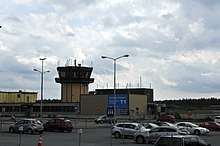Tampere
Tampere (/ˈtæmpəreɪ/, also US: /ˈtɑːm-/;[7][8] Finnish: [ˈtɑmpere] (![]()
![]()
Tampere Tammerfors | |
|---|---|
City | |
| Tampereen kaupunkiTammerfors stad | |
 Clockwise from top-left: the cityscape (viewed from Näsinneula); Tampere City Hall; Särkänniemi (from Näsinneula); Tampere Hall; the skyline with Näsinneula; Tammerkoski from Hämeensilta Bridge; and the Cathedral. | |
 Flag 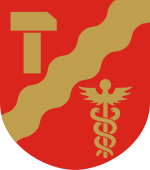 Coat of arms | |
| Nickname(s): Manchester of the North, Manse (in Finnish), Nääsville (in Finnish), Sauna Capital of the World | |
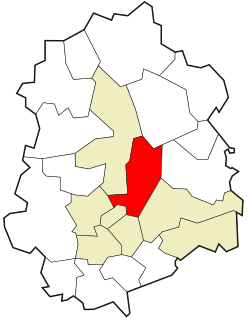 | |
| Coordinates: 61°30′N 23°46′E | |
| Country | |
| Region | |
| Sub-region | Tampere |
| Founded | 1779 |
| Government | |
| • Mayor | Lauri Lyly |
| Area (2018-01-01)[1] | |
| • City | 689.59 km2 (266.25 sq mi) |
| • Land | 525.03 km2 (202.72 sq mi) |
| • Water | 164.56 km2 (63.54 sq mi) |
| • Urban | 258.52 km2 (99.82 sq mi) |
| Area rank | 166th largest in Finland |
| Population (2019-01-31)[2] | |
| • City | 235,615 |
| • Rank | 3rd largest in Finland |
| • Density | 448.76/km2 (1,162.3/sq mi) |
| • Urban | 334,112[3] |
| • Urban density | 1,211.0/km2 (3,136/sq mi) |
| • Metro | 376,445 |
| Population by native language | |
| • Finnish | 94.9% (official) |
| • Swedish | 0.5% |
| • Others | 4.5% |
| Population by age | |
| • 0 to 14 | 13.8% |
| • 15 to 64 | 70.6% |
| • 65 or older | 15.7% |
| Time zone | UTC+02:00 (EET) |
| • Summer (DST) | UTC+03:00 (EEST) |
| Municipal tax rate[6] | 19% |
| Unemployment rate | 14.8% |
| Website | Tampere |
Tampere has a population of 238,140 with the urban area holding 334,112 people[10] and the metropolitan area, also known as the Tampere sub-region, holding 385,301 inhabitants in an area of 4,970 km2.[11] Tampere is the second-largest urban area[12] and third most-populous individual municipality in Finland, after the cities of Helsinki and Espoo and the most populous Finnish city outside the Greater Helsinki area, within which both Helsinki and Espoo are located. Tampere is a major urban, economic, and cultural hub for central Finland.
Tampere is wedged between two lakes, Näsijärvi and Pyhäjärvi. Since the two lakes differ in level by 18 metres (59 ft), the rapids linking them, Tammerkoski, have been an important power source throughout history, most recently for generating electricity. Tampere is dubbed the "Manchester of Finland" for its industrial past as the former center of Finnish industry, and this has given rise to its Finnish nickname "Manse" and terms such as "Manserock".[13][14][15]
Helsinki is approximately 160 kilometres (100 mi) south of Tampere, and can be reached in 1 hr, 31 minutes by Pendolino high-speed rail service[16] and 2 hours by car. The distance to Turku is roughly the same. Tampere–Pirkkala Airport is Finland's eighth-busiest airport, with over 230,000 passengers in 2017.[17]
Tampere ranked 26th in the list of 446 cities in the world's hipster cities.[18] Also, Tampere has been officially declared the "Sauna Capital of the World", because it has the most public saunas in the world.[19][20][21][22]
By 2021, a new multi-purpose sports and entertainment center, Tampere Deck Arena, is nearing completion.[23]
Names and etymology
Although the name Tampere is derived from the Tammerkoski rapids (both the city and the rapids are called Tammerfors in Swedish), the origin of the Tammer- part of that name has been the subject of much debate. Ánte accepts the "straightforward" etymology of Rahkonen and Heikkilä in Proto-Samic *Tëmpël(kōškë), *tëmpël meaning "deep, slow section of a stream" and *kōškë "rapids" (cognate with the Finnish koski).[24][25][26] Other theories include that it comes from the Swedish word damber, meaning milldam; another, that it originates from the ancient Scandinavian words þambr ("thick bellied") and þambion ("swollen belly"), possibly referring to the shape of the rapids. Another suggestion links the name to the Swedish word Kvatemberdagar, or more colloquially Tamperdagar, meaning the Ember days of the Western Christian liturgical calendar. The Finnish word for oak, tammi, also features in the speculation,[27] although Tampere is situated outside[28] the natural distribution range of the European oak and the town was founded by Swedes, which makes this explanation less plausible.
History
Tampere was founded as a market place on the banks of the Tammerkoski channel in 1775 by Gustav III of Sweden and four years later, 1 October 1779,[29] Tampere was granted full city rights. At this time, it was a rather small town, consisting of only a few square kilometres of land around the rapids.
Tampere grew as a major market town and industrial centre in the 19th century;[30] the industrialization of Tampere was mainly influenced by the Finlayson textile factory, founded in 1820 by the Scottish industrialist James Finlayson.
Tampere was the centre of many important political events of Finland in the early 20th century. On 1 November 1905, during the general strike, the famous Red Declaration was proclaimed on Keskustori.[31] In 1918, after Finland had gained independence, Tampere played a major role, being one of the strategically important sites during the Civil War in Finland (28 January – 15 May 1918). Tampere was a red stronghold during the war, with Hugo Salmela in command. White forces captured the town after the Battle of Tampere, seizing about 10,000 Red prisoners on 6 April 1918.[32][33]
Prevalent in Tampere's post-World War II municipal politics was the Brothers-in-Arms Axis (aseveliakseli).[34]
After World War II, Tampere was enlarged by joining some neighbouring areas. Messukylä was incorporated in 1947, Lielahti in 1950, Aitolahti in 1966 and finally Teisko in 1972. Tampere was known for its textile and metal industries, but these have been largely replaced by information technology and telecommunications during the 1990s. The technology centre Hermia in Hervanta is home to many companies in these fields.
Geography
Tampere is part of the Pirkanmaa region and is surrounded by the municipalities of Kangasala, Lempäälä, Nokia, Orivesi, Pirkkala, Ruovesi, and Ylöjärvi.[35]
Neighbourhoods and other subdivisions
Climate
Tampere has a typical subarctic climate (Köppen climate classification Dfc) at the Tampere–Pirkkala Airport (TMP) with only 3 months above 10 °C (50 °F),[36][37] bordering on a warm-summer humid continental climate (Köppen climate classification Dfb). Winters are cold and the average temperature from November to March is below 0 °C (32 °F). Summers are cool to warm. On average, snow cover lasts 4–5 months from late November to early April. Considering it being at the subarctic threshold and inland, winters are, on average, quite mild for the classification, as is the annual mean temperature.
| Climate data for Tampere–Pirkkala Airport (TMP), elevation: 119 metres (390 ft),[lower-alpha 1] 1981–2010 normals, extremes 1900–present | |||||||||||||
|---|---|---|---|---|---|---|---|---|---|---|---|---|---|
| Month | Jan | Feb | Mar | Apr | May | Jun | Jul | Aug | Sep | Oct | Nov | Dec | Year |
| Record high °C (°F) | 8.0 (46.4) |
9.4 (48.9) |
14.9 (58.8) |
24.2 (75.6) |
28.4 (83.1) |
31.7 (89.1) |
33.1 (91.6) |
32.1 (89.8) |
24.8 (76.6) |
18.4 (65.1) |
11.1 (52.0) |
9.6 (49.3) |
33.1 (91.6) |
| Average high °C (°F) | −3.4 (25.9) |
−3.5 (25.7) |
1.2 (34.2) |
8.2 (46.8) |
15.4 (59.7) |
19.5 (67.1) |
22.2 (72.0) |
19.9 (67.8) |
14.0 (57.2) |
7.5 (45.5) |
1.5 (34.7) |
−1.9 (28.6) |
8.4 (47.1) |
| Daily mean °C (°F) | −6.4 (20.5) |
−6.9 (19.6) |
−2.8 (27.0) |
3.3 (37.9) |
9.7 (49.5) |
14.1 (57.4) |
16.9 (62.4) |
15.0 (59.0) |
9.8 (49.6) |
4.6 (40.3) |
−0.6 (30.9) |
−4.5 (23.9) |
4.4 (39.9) |
| Average low °C (°F) | −9.7 (14.5) |
−10.6 (12.9) |
−6.6 (20.1) |
−1.3 (29.7) |
3.8 (38.8) |
8.6 (47.5) |
11.7 (53.1) |
10.4 (50.7) |
5.9 (42.6) |
1.9 (35.4) |
−3.0 (26.6) |
−7.6 (18.3) |
0.3 (32.5) |
| Record low °C (°F) | −37.0 (−34.6) |
−36.8 (−34.2) |
−29.6 (−21.3) |
−19.6 (−3.3) |
−7.3 (18.9) |
−2.8 (27.0) |
1.8 (35.2) |
−0.4 (31.3) |
−6.7 (19.9) |
−14.8 (5.4) |
−22.5 (−8.5) |
−34.2 (−29.6) |
−37.0 (−34.6) |
| Average precipitation mm (inches) | 41 (1.6) |
29 (1.1) |
31 (1.2) |
32 (1.3) |
41 (1.6) |
66 (2.6) |
75 (3.0) |
72 (2.8) |
58 (2.3) |
60 (2.4) |
51 (2.0) |
42 (1.7) |
598 (23.5) |
| Average precipitation days (≥ 0.1 mm) | 22 | 18 | 16 | 12 | 12 | 13 | 15 | 15 | 14 | 17 | 21 | 22 | 197 |
| Average relative humidity (%) | 90 | 87 | 82 | 70 | 63 | 66 | 69 | 76 | 82 | 87 | 91 | 92 | 80 |
| Source 1: FMI[37] | |||||||||||||
| Source 2: FMI (record highs and lows)[38] | |||||||||||||
Temperature records of Tampere
Temperature records of Tampere and the near-by Tampere–Pirkkala Airport:[39]
Temperature Records of Tampere | ||||||||||||||||||||||||||||||||||||||||||||||||||||||||||||||||||||||||||||||||||||||||||||||||||||||||||||||||||||||||||
|---|---|---|---|---|---|---|---|---|---|---|---|---|---|---|---|---|---|---|---|---|---|---|---|---|---|---|---|---|---|---|---|---|---|---|---|---|---|---|---|---|---|---|---|---|---|---|---|---|---|---|---|---|---|---|---|---|---|---|---|---|---|---|---|---|---|---|---|---|---|---|---|---|---|---|---|---|---|---|---|---|---|---|---|---|---|---|---|---|---|---|---|---|---|---|---|---|---|---|---|---|---|---|---|---|---|---|---|---|---|---|---|---|---|---|---|---|---|---|---|---|---|---|
Highest temperatures at the Tampere–Pirkkala Airport by month since 1980:[39]
Lowest temperatures in Tampere:[39]
Lowest temperatures at the Tampere–Pirkkala Airport by month since 1980:[39]
| ||||||||||||||||||||||||||||||||||||||||||||||||||||||||||||||||||||||||||||||||||||||||||||||||||||||||||||||||||||||||||
Economy

The Tampere region, Pirkanmaa, which includes outlying municipalities, has around 509,000 residents,[40] 244,000 employed people,[41] and a turnover of 28 billion euros as of 2014.[42] According to the Tampere International Business Office, the area is strong in mechanical engineering and automation, information and communication technologies, and health and biotechnology, as well as pulp and paper industry education. Unemployment rate was 14.8% in June 2017.
| People with a foreign background[43][44] | |
|---|---|
| County of origin | Population (2017) |
| Russia | 3,178 |
| Iraq | 1,566 |
| Afghanistan | 1,170 |
| Sweden | 1,121 |
| Estonia | 1,074 |
| China | 708 |
| Iran | 684 |
| Somalia | 545 |
| India | 534 |
| Yugoslavia | 487 |
Education
There are three institutions of higher education in the Tampere area totaling 40,000 students: the university and two polytechnic institutions (Finnish: ammattikorkeakoulu). Tampere University (TUNI) has over 20,000 students and is located in two campuses, one in the Kalevanharju district, close to the city centre, and one in Hervanta, in the southern part of the city. The institution was formed in 2019 as a result of the merge of University of Tampere (UTA) and Tampere University of Technology (TUT). TUNI is also the major shareholder of the Tampere University of Applied Sciences (Tampereen ammattikorkeakoulu, TAMK), a polytechnic counting about 10,000 students.[45] The Police University College, the polytechnic institution serving all of Finland in its field of specialization, is also located in Tampere.[46][47]
Tampere University Hospital (Tampereen yliopistollinen sairaala, TAYS), one of the main hospitals in Finland, is affiliated with Tampere University. It is a teaching hospital with 34 medical specializations.
Arts and culture
Tampere is known for its active cultural life. Some of the most popular writers in Finland, such as Väinö Linna, Kalle Päätalo, and Hannu Salama, hail from Tampere. These authors are known particularly as writers depicting the lives of working-class people, thanks to their respective backgrounds as members of the working class. Also from such a background was the famous poet Lauri Viita of the Pispala district, which was also the original home of the aforementioned Hannu Salama.
Tampere is home to the television channel Yle TV2, with its studios in the Ristimäki district, known for popular TV comedies such as Tankki täyteen, Reinikainen and Kummeli. The Tampere Film Festival, an annual international short film event, is held every March. Tammerfest, Tampere's urban rock festival, is held every July. The Tampere Floral Festival is an annual event, held each Summer.
The city is also known as the home of the popular Hydraulic Press Channel on YouTube, which originates from a machine shop owned by Lauri Vuohensilta.[48]
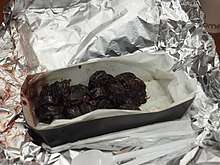

A local food speciality is mustamakkara, which resembles the black pudding of northern England. It is a black sausage made by mixing pork, pig's blood and crushed rye and flour and is stuffed into the intestines of an animal. It is commonly eaten with lingonberry sauce. Especially Tammelantori square in the district of Tammela is famous for its mustamakkara kiosks.[49]
Music
Tampere is home to the Tampere Philharmonic Orchestra (Tampere Filharmonia), which is one of only two full-sized symphony orchestras in Finland; the other one is located in Helsinki. The orchestra's home venue is the Tampere Hall, and their concerts include classical, popular, and film music. Tampere Music Festivals organises three international music events: The Tampere Jazz Happening each November, and in alternate years The Tampere Vocal Music Festival and the Tampere Biennale. Professional education in many fields of classical music, including performing arts, pedagogic arts, and composition, is provided by Tampere University of Applied Sciences and Tampere Conservatoire.
The popular music scene in Tampere is often considered to have begun in August 1969 when the famous musical Hair was performed for the first time in a local theatre.
Manserock became a general term for rock music from Tampere, which was essentially rock music with Finnish lyrics. Manserock was especially popular during the 1970s and 1980s, and its most popular artists included Juice Leskinen, Virtanen, Kaseva, Popeda, and Eppu Normaali. In 1977, Poko Records, the first record company in Tampere, was founded.
In the 2010s, there has been a lot of popular musical activity in Tampere, particularly in the fields of rock and heavy/black metal. Some of the most popular bands based in Tampere include Negative, Uniklubi, and Lovex. Tampere also has an active electronic music scene. Tampere hosts an annual World of Tango Festival (Maailmantango).[50]
Theatre
Tampere has a lengthy tradition of theater, with established institutions such as Tampereen Työväen Teatteri, Tampereen Teatteri, and Pyynikin Kesäteatteri, which is an open-air theatre with the oldest revolving auditorium in Europe. The Tampere Theatre Festival (Tampereen teatterikesä) is an international theatre festival held in the city each August.
Religion

As is the case with most of the rest of Finland, most Tampere citizens belong to the Evangelical Lutheran Church of Finland. One Lutheran church in Tampere is Finlayson Church. Tampere also has a variety of other religious services spanning from traditional to charismatic. There are also some English speaking services, such as the Tampere English Service, an international community affiliated with the Tampere Pentecostal Church. English services of the International Congregation of Christ the King (ICCK) are organized by the Anglican Church in Finland and the Lutheran Parishes of Tampere. The Catholic parish of the Holy Cross[51] also offers services in Finnish, Polish and English. Other churches may also have English speaking ministries. Tampere is the center of a LDS stake (diocese). Other churches in Tampere are the Baptist Church, the Evangelical Free Church, the Evangelical Lutheran Mission Diocese of Finland, the Finnish Orthodox Church and the Nokia Revival.
The Jews had an organized community until 1981. Though a small number of Jews remain in Tampere, organized communal life ended at that time.[52]
City rivalry with Turku
Tampere ostensibly has a long-standing mutual feud with the city of Turku, the first capital of Finland. This hostility is largely expressed in jokes in one city about the other; prominent targets are the traditional Tampere food, mustamakkara, the state of the Aura River in Turku, and the regional accents. Tampere is well known as a food destination because of its food culture. Since 1997, students at Tampere have made annual excursions to Turku to jump on the market square, doing their part to undo the post-glacial rebound and push the city back into the Baltic Sea.[53]
Sites of interest

One of the main tourist attractions is the Särkänniemi amusement park, which includes the landmark Näsinneula tower, topped by a revolving restaurant. In addition to these, it used to house a dolphinarium. Other sites of interest are Tampere Cathedral, Tampere City Hall, Tampere Central Library Metso ("Capercaillie"), Kaleva Church (both designed by Reima Pietilä), the Tampere Hall (along Hämeenkatu) for conferences and concerts, and the Tampere Market Hall.
Tampere have at least seven hotels, the most noteworthy of which are Hotel Tammer, Hotel Ilves, and Hotel Torni, the tallest hotel building in Finland.[55]
Tampere is also home to one of the last museums in the world dedicated to Vladimir Lenin. The museum is housed in the Tampere Workers' Hall (along Hallituskatu) where during a subsequent Bolshevik conference in the city, Lenin met Joseph Stalin for the first time. Lenin moved to Tampere in August 1905, but eventually fled for Sweden in November 1907 when being pursued by the Russian Okhrana. Lenin would not return to any part of the Russian Empire until ten years later, when he heard of the start of the Russian Revolution of 1917.
There are many museums and galleries, including:
- The Vapriikki Museum Centre[56] which includes the Natural History Museum of Tampere, Finnish Hockey Hall of Fame, Finnish Museum of Games, Post Museum and the Shoe Museum
- Tampere Art Museum[57]
- Tampere Lenin Museum
- The Moomin Museum,[58] about Moomins
- Rupriikki Media Museum
- Spy Museum in Siperia[59]
- Workers' housing museum in Amuri.[60]
- Finland's largest glass sculpture, owned by the City of Tampere, "Pack Ice / The Mirror of the Sea" by the renowned artist Timo Sarpaneva, was installed in the entrance lobby of the downtown shopping mall KoskiKeskus until it was moved to a warehouse.[61]
Pispala
Pispala is a ridge located between the two lakes. It's the highest gravel ridge in the world, raising 80 metres (260 ft) above Lake Pyhäjärvi and around 160 metres (520 ft) above sea level. It was used to house the majority of industrial labour in the late 19th and early 20th century, when it was part of Suur-Pirkkala and its successor Pohjois-Pirkkala. It was a free area to be built upon by the working-class people working in Tampere factories. It joined Tampere in 1937. Currently it is a residential area undergoing significant redevelopment and together with neighbouring Pyynikki it forms an important historical area of Tampere.
Events
Sports
Tampere's sporting scene is mainly driven by ice hockey. The first Finnish ice hockey match was played in Tampere, on the ice of Pyhäjärvi. Tampere is nicknamed the hometown of Finnish ice hockey. Two exceptional ice hockey teams come from Tampere: Ilves and Tappara. They both have had a great impact on Finnish ice hockey culture and are among the most successful teams in Finland. The Finnish ice hockey museum, and the first ice hockey arena to be built in Finland, the Hakametsä arena, are both located in Tampere. Construction of a new main ice hockey arena, Tampere Deck Arena, began in 2018, and is supposed to be finished by 2021. The name of the new arena will be UROS LIVE.[62]
Association Football is also a popular sport in Tampere. Ilves alone has over 4,000 players in its football teams, while Tampere boasts over 100 (mostly junior) football teams. Basketball is another popular sport in Tampere. The city has three basketball teams with big junior activity and one of them, Tampereen Pyrintö, plays on the highest level (Korisliiga) and was the Finnish Champion in 2010, 2011, and 2014. Tampere Saints is the American football club in the city. The Saints won division 2 in 2015 and plays in the Maple League (division 1) in summer 2017.
Tampere hosted some of the preliminaries for the 1952 Summer Olympics, the 1965 World Ice Hockey Championships and was co-host of the EuroBasket 1967. The city also hosted two canoe sprint world championships, in 1973 and 1983. In 1977, Tampere hosted the World Rowing Junior Championships and in 1995 the Senior World Rowing Championships. Recently, Tampere was the host of the 10th European Youth Olympic Festival from 17 to 25 July 2009 and the 2010 World Ringette Championships from 1 to 6 November at Hakametsä arena.
Concerts
Ratina Stadium of Tampere has served as the venue for many of the most significant concerts, most notably in connection with the Endless Forms Most Beautiful World Tour in 2016 by the Nightwish band.[63][64] Other noteworthy tours from other bands held at Ratina Stadium include Iron Maiden (Somewhere Back in Time World Tour, 2008), Bruce Springsteen (Working on a Dream Tour, 2009), AC/DC (Black Ice World Tour, 2010), Red Hot Chili Peppers (I'm with You World Tour, 2012), Bon Jovi (Because We Can World Tour, 2013), Robbie Williams (The Heavy Entertainment Show Tour, 2017) and Rammstein (Rammstein Stadium Tour, 2019).
Transport
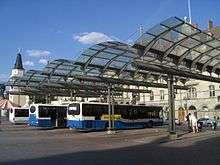
Tampere is an important railroad hub in Finland and there are direct railroad connections to, for example, Helsinki, Turku and the Port of Turku, Oulu, Jyväskylä, and Pori. The Tampere Central Railway Station is located in the city center. There are also frequent bus connections to destinations around Finland. To the south of Tampere, there is the Tampere Ring Road, which is important for car traffic and which is part of Finnish highways number 3 (on the west side) and number 9 (on the east side).
Tampere is served by Tampere–Pirkkala Airport, located in neighboring municipality Pirkkala some 13 km (8 mi) southwest of the city.
The public transport network in Tampere currently consists solely of a bus network. Between 1948 and 1976 the city also had an extensive trolleybus network, which was also the largest trolleybus system in Finland.[65] As of 2017, construction is underway for a light rail system in the city to replace some of the more popular bus lines (see Tampere light rail), as well as initiating commuter rail service on the railroad lines connecting Tampere to the neighbouring towns of Nokia and Lempäälä.[66]
Government
In 2007, Tampere switched to a new model of government. Since then, a mayor and four deputy mayors have been chosen for a period of two years by the city council. The mayor also becomes the seat of the city council for the duration of the tenure.
Mayors over time
- Kaarle Nordlund 1929–1943
- Sulo Typpö 1943–1957
- Erkki Lindfors 1957–1969
- Pekka Paavola 1969–1985
- Jarmo Rantanen 1985–2007
- Timo P. Nieminen (kok.) 2007–2012
- Anna-Kaisa Ikonen (kok.) 2013–2017
- Lauri Lyly (sd.) 2017– and is set to rule till 2019.
Notable people
For a list of notable persons, see Category:People from Tampere.
International relations
Twin towns – sister cities
Tampere is twinned with:
Notes
- Mean value of the airport and not the weather station
References
- "Area of Finnish Municipalities 1.1.2018" (PDF). National Land Survey of Finland. Retrieved 30 January 2018.
- "Suomen virallinen tilasto (SVT): Väestön ennakkotilasto [verkkojulkaisu]. Tammikuu 2019" (in Finnish). Statistics Finland. Retrieved 15 March 2019.
- "Taajamat väkiluvun ja väestöntiheyden mukaan 31.12.2017" (in Finnish). Statistics Finland (Tilastokeskus). 31 December 2017. Retrieved 21 October 2018.
- "Population according to language and the number of foreigners and land area km2 by area as of 31 December 2008". Statistics Finland's PX-Web databases. Statistics Finland. Retrieved 29 March 2009.
- "Population according to age and gender by area as of 31 December 2008". Statistics Finland's PX-Web databases. Statistics Finland. Retrieved 28 April 2009.
- "List of municipal and parish tax rates in 2011". Tax Administration of Finland. 29 November 2010. Retrieved 13 March 2011.
- "Tampere". The American Heritage Dictionary of the English Language (5th ed.). Boston: Houghton Mifflin Harcourt. Retrieved 10 May 2019.
- "Tampere" (US) and "Tampere". Oxford Dictionaries UK Dictionary. Oxford University Press. Retrieved 10 May 2019.
- YLE: Tampere rated Finland’s most popular city
- http://pxnet2.stat.fi/PXWeb/sq/960bccd6-df90-4e56-acd3-8be6c28323d5 Taajamat väkiluvun ja väestöntiheyden mukaan 31 December 2017
- "Facts and figures". tampereenseutu.fi. Retrieved 29 March 2018.
- A dynamic city of growth – Tampere is the second largest urban centre in Finland
- "Tampere in brief" (PDF). Archived from the original (PDF) on 27 September 2011. Retrieved 15 September 2011.
- Tampere Economy, Tampere International Business Office Archived 27 March 2009 at the Wayback Machine
- Katko, Tapio S. and Juuti, Petri S. Watering the city of Tampere Archived 27 September 2011 at the Wayback Machine, publications of the 5th IWHA Conference, 2007. Available at the website of the city of Tampere.
- "Now Finland is even faster - VR". www.vr.fi.
- "Passenger stats" (PDF). www.finavia.fi. Retrieved 4 February 2020.
- WORLD’S MOST HIPSTER CITIES REVEALED: TAMPERE RANKED NUMBER 26!
- Tampere is the Sauna Capital of the World
- Finnish Sauna Society and International Sauna Association: “Tampere is the Sauna Capital”
- Tampere – the sauna capital of the world
- Tampere – the Sauna Capital of the World ~ Sauna from Finland
- Tampere Deck Arena – Visit Tampere
- Ánte, Luobbal Sámmol Sámmol (2012), "An essay on Saami ethnolinguistic prehistory", A Linguistic Map of Prehistoric Northern Europe, Mémoires de la Société Finno-Ougrienne, 266, pp. 63–117
- Heikkilä, Mikko (2012), "Tampere–saamelaisen Tammerkosken kaupunki", Virittäjä, 1
- Rahkonen, Pauli (2011), "Tampere–saamelainen koskiappellatiivi", Virittäjä, 2
- "Utain – Tampereen yliopiston toimittajakoulutuksen viikkolehti". Uta.fi. Archived from the original on 26 March 2005. Retrieved 3 June 2011.
- "Metsätammi (Quercus robur)". Kasviatlas. Retrieved 3 September 2017.
- "The City Of Tampere – Tampere in brief – History". Archived from the original on 28 December 2009.
- Andy Symington; George Dunford (2009). Finland. Lonely Planet. pp. 224–225. ISBN 978-1-74104-771-4.
- Gary Kaunonen (19 February 2010). Challenge Accepted: A Finnish Immigrant Response to Industrial America in Michigan's Copper Country. MSU Press. p. 22. ISBN 978-1-62895-154-7.
- The Finnish Civil War 1918: History, Memory, Legacy. BRILL. 14 August 2014. p. 100. ISBN 978-90-04-28071-7.
- Roger Norum (1 June 2010). The Rough Guide to Finland. Rough Guides. p. 438. ISBN 978-1-84836-969-6.
- Marianne Ekman; Björn Gustavsen; Bjorn Terje Asheim (15 January 2011). Learning Regional Innovation: Scandinavian Models. Palgrave Macmillan. p. 174. ISBN 978-0-230-27560-7.
- "Paikkatietoikkuna". Paikkatietoikkuna.fi. maanmittauslaitos.fi. Retrieved 9 October 2019.
- "Pirkkala, Pirkanmaa, Western Finland, Finland – City, Town and Village of the world". en.db-city.com. Retrieved 4 March 2019.
- "FMI normals 1981–2010" (PDF). FMI. Retrieved 26 April 2016.
- "FMI open data". FMI. Retrieved 13 October 2017.
- "Temperatures in Tampere". Retrieved 31 July 2019.
- "EURES - Labour market information - Pirkanmaa - European Commission". ec.europa.eu.
- "Appendix table 1. Turnover of establishments by region in 2014". stat.fi. Statistics Finland. 18 December 2015. Retrieved 2 October 2017.
- "Tampere Region The Council of Tampere Region 2017" (PDF). Retrieved 2 October 2017.
- http://pxnet2.stat.fi/PXWeb/pxweb/fi/StatFin/StatFin__vrm__vaerak/statfin_vaerak_pxt_032.px/table/tableViewLayout2/?rxid=726cd24d-d0f1-416a-8eec-7ce9b82fd5a4%5B%5D
- "Archived copy". Archived from the original on 29 June 2018. Retrieved 26 August 2018.CS1 maint: archived copy as title (link)
- TAMK. 22 January 2010. Tampere polytechnic. Retrieved 31 January 2010.
- "Together we are greater | Tampere universities". www.tuni.fi. Tampere University. Retrieved 20 December 2018.
- Tampere3: A motor, developer and interpreter of an affluent society . Tampere3. Retrieved 14 May 2018.
- Sensenig, Kate (19 April 2016). "Welcome to the 'Hydraulic Press' YouTube channel, a truly crushing experience". The Washington Post. Retrieved 3 June 2016.
- Aleksandrou, Anna Maria (8 November 2012). "The black sausage is the pride of Tampere". Helsinki Times. Retrieved 16 May 2019.
- C.G. (11 October 2017). "Explaining the Finnish love of tango". The Economist.
- "Pyhä Risti Seurakunta". Kolumbus.fi. Retrieved 3 June 2011.
- "About Our Community". Jewish Community of Helsinki (in Finnish and English). Archived from the original on 1 November 2015. Retrieved 27 November 2017.
- "Data" (PDF). www.students.tut.fi. Retrieved 4 February 2020.
- Mixei
- "Finland's tallest hotel can now be found in Tampere". Visit Finland. 20 November 2014. Retrieved 15 June 2020.
- "Museum Centre Vapriikki [City of Tampere]". tampere.fi. Retrieved 25 January 2014.
- "Tampere Art Museum [City of Tampere]". tampere.fi. Archived from the original on 17 December 2016. Retrieved 25 January 2014.
- "Front Page – Muumimuseo". Retrieved 3 June 2011.
- "Vakoilumuseo – Spy Museum". Vakoilumuseo.fi. Archived from the original on 20 July 2011. Retrieved 3 June 2011.
- "City of Tampere – Amuri museum of workers' housing". Tampere.fi. 10 May 2011. Archived from the original on 8 July 2011. Retrieved 3 June 2011.
- "Ahtojäälle ei ole helppo löytää uutta kotia". Yle Uutiset (in Finnish). Retrieved 25 November 2017.
- https://yle.fi/uutiset/3-11241911
- NIGHTWISH – The Greatest Show(s) On Earth (in Italian)
- Greatest show on Earth - Matkailua pilke silmäkulmassa (in Finnish)
- Alameri, Mikko. "Trolleybus City of Tampere". Raitio (in Finnish). Suomen Raitiotieseura. Archived from the original on 13 December 2007. Retrieved 28 February 2009.
- "Joukkoliikennejärjestelmävaihtoehdot – Vaikutusten arviointi ja suositus Tampereen kaupunkiseudun joukkoliikennejärjestelmäksi" (PDF). TASE 2025 (in Finnish). City of Tampere. March 2007. Archived from the original (PDF) on 27 March 2009. Retrieved 28 February 2009.
- "Twin Cities". City of Tampere. 15 February 2016. Archived from the original on 6 October 2018. Retrieved 6 October 2018.
- "List of Twin Towns in the Ruhr District" (PDF). Twins2010.com. Archived from the original (PDF) on 28 November 2009. Retrieved 28 October 2009.
- "Miasta partnerskie – Urząd Miasta Łodzi [via WaybackMachine.com]". City of Łódź (in Polish). Archived from the original on 24 June 2013. Retrieved 21 July 2013.
- "Trondheims offisielle nettsted – Vennskapsbyer" (in Norwegian). Trondheim.com. Archived from the original on 27 September 2011. Retrieved 4 September 2011.
- "Guangzhou Sister Cities [via WaybackMachine.com]". Guangzhou Foreign Affairs Office. Archived from the original on 24 October 2012. Retrieved 21 July 2013.
- "Some 15 Finnish towns have twinned with friendship cities in China". Helsingin Sanomat International Edition. 20 June 2013. Retrieved 29 July 2013.
External links
| Wikimedia Commons has media related to Tampere. |
- City of Tampere – Official website
- The official Tampere Region visitor website
- Virtual City Guide: VirtualTampere.com
- 1952 Summer Olympics official report pp. 62–3.
- Tammerkoski Heritage – Town's Industrial Heritage Portal
- CSSA Tampere Ry
- Lunch restaurants in Tampere

- Chisholm, Hugh, ed. (1911). . Encyclopædia Britannica (11th ed.). Cambridge University Press.
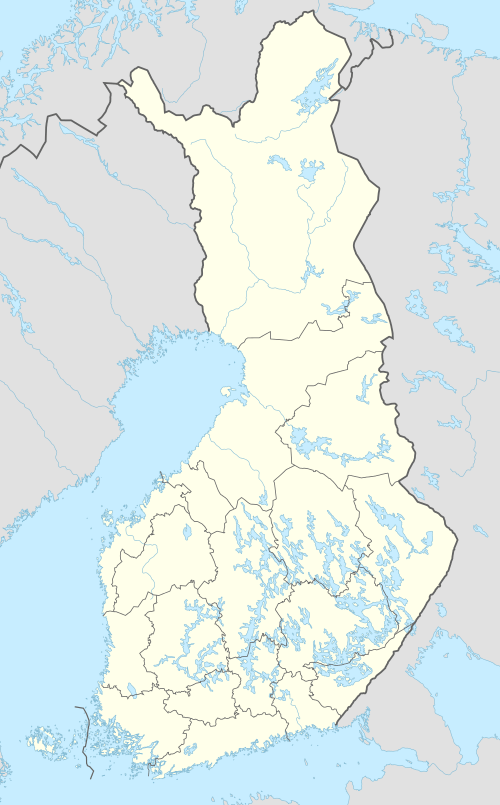

%2C_Finland%2C_architect_Kosti_Kuronen.jpg)
